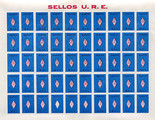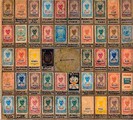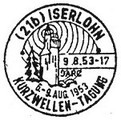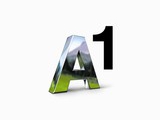<-- Amateur radio QSL stamps

![]() Today only a few countries and organisations offeer these stamps. They were most popular in the fifties and sixties. Take a look.
Today only a few countries and organisations offeer these stamps. They were most popular in the fifties and sixties. Take a look.
Anton Haddeman's, PA3DBJ, QSL stamp collection: ![]() ext. Link
ext. Link
Michael McNamara's, EI2CL. QSL stamp collection: ![]() ext. Link
ext. Link
Max C. de Henseler's, HB9KS, QSL stamp collection (PDF): ![]() ext. Link
ext. Link
<-- Radio verfication stamps
A complete list of US radio stations 1922-1946 and Canadian and Mexican stations can be found in our membership only section

![]() Their idea was to sell to the emerging radio broadcasting industry a marketing tool to help promote public interest in specific radio stations. The EKKO Company contracted with THE AMERICAN BANK NOTE COMPANY to design, and produce to order, stamps of the same high quality as current postage printings, to be used by commercial broadcasters in promoting their stations and radio shows to the listening public. The genius of this concept, intentional or not, was the combining of a popular hobby, stamp collecting, with the new and exciting pastime of listening to radio broadcasts from far away!
Their idea was to sell to the emerging radio broadcasting industry a marketing tool to help promote public interest in specific radio stations. The EKKO Company contracted with THE AMERICAN BANK NOTE COMPANY to design, and produce to order, stamps of the same high quality as current postage printings, to be used by commercial broadcasters in promoting their stations and radio shows to the listening public. The genius of this concept, intentional or not, was the combining of a popular hobby, stamp collecting, with the new and exciting pastime of listening to radio broadcasts from far away!
Unsubstantiated rumor has it that the American Bank Note Company quickly redesigned a stamp that had been submitted to, and rejected by, the United Stated Postal Services and that the EKKO Company accepted the design but insisted on the use of numerous colors for their customers. The stamps, framing the American Bald Eagle with two radio towers in the background and a station bar where the broadcast station call letters could be imprinted, measured in frame height 35mm and in frame width 22mm. With perforation (12) and plate cuts, the finished stamps measured approximately 40mm in height and 25mm in width, familiar dimensions to American postage stamp collectors.
These stamps, often referred to as "Cinderella's" by todays collectors, would be purchased by the radio stations from the EKKO Company and then, when their respective listeners provided written information identifying the details and proving that they had indeed tuned in and listened to a particular broadcast, the station would send the listener a VERIFIED RECEPTION STAMP (VRS) with the station's call letters.
The listener was suppose to provide the date and time they had listened to the broadcast as well as details as to what they had heard, and then send the information along with 10 cents to the radio station. The radio station would check it's broadcast log and confirm, or verify that the information was correct, and if so, then in return send the listener a VRS stamp.
To further keep this new hobby growing, the EKKO Company recognized that they would have to provide collectors a means to complete their collections, something that was impossible to do under the "rules" since most broadcast stations were not powerful enough to send out signals that would reach the entire country, which meant that collectors would not be able to comply with the written detail requirement in order to get the stamps from the broadcast stations directly. To the dismay of their customers, the broadcast stations, in 1925 the EKKO Company began selling the stamps directly to the public.
When the EKKO Company published their hardback album in 1924, they were selling stamps to 592 stations in the United States and Canada, and at the height of the collecting craze they were selling their stamps simultaneously to slightly more than 650 broadcast stations located throughout North America and the Caribbean! It is commonly accepted that this is the maximum number of stations, however, our research has identified over 844 stations that participated in the program between 1921 and 1929, and the list continues to grow! These stations were located in the United States, Canada, Cuba and Mexico.
Of course, success breeds imitation, and there were a number of companies that attempted to compete with the EKKO Company in offering stamps to broadcast stations, which added to the variety and scope of collectibles, but which may have ultimately hastened the demise in popularity of the hobby. In addition, several radio stations decided to design and offer their own version of these stamps, with many being so unique and rare today as to be very valuable. Not surprisingly, being that stamp collecting was after all the hobby of kings, none of the major suppliers issued a comprehensive album, and so collectors tended to simply paste these non-EKKO examples into their EKKO Albums.
As these stamps became more and more popular, the EKKO Company expanded it's market with the issue of a second EKKO design, this one with a beaver instead of an eagle, which was for the Canadian broadcasters to use with their listeners. The EKKO Company also sold stamps to broadcasters in Mexico and the Caribbean, but used the American Eagle design. These stations, because there are so few, are extremely rare in todays marketplace!
In the original printing sequences employed by the American Bank Note Company, the first sequence was the body of the stamp which included the Eagle or Beaver but did not include the station call sign letters or the words "verified reception stamp". This allowed the printing in large enough quantities to make the stamps affordable while still allowing for customization of the call letters of a particular radio station. For reasons unknown, the second sequence was the printing of the words "verified reception stamp" directly below the station bar, and when the EKKO Company sold stamps to a broadcasting station, then the third printing sequence, the adding of the station call letters, was completed. This also allowed the call letters and the vrs wording to be printed in the same color. The primary colors for the American stamps are Red; Grey; Blue; Green; Orange; Gold, Purple and Brown and there were 16 secondary colors which were shades of the primary colors, for example, there is a light blue, a medium blue and a dark blue. The primary colors for the call letters and VRS wording were Black; Dark Blue; Red; and while rare, Green. For the Canadian Beaver design, the colors were more a pastel variety, with basically the same primary colors as the American version but with no secondary shades. The Canadian call letters and VRS wording were almost always printed in Black; Red or Dark Blue.
The sequential printing process was suppose to result in a finished product equal to that of postage stamps but because of plating alignment problems, it is quite rare to find an example where the station call letters and vrs are centered correctly to the stamp body, and such premium examples are highly sought after by today's collector. In addition, and considered to be error's, there are examples where the Call Letters are centered correctly and the vrs letters are not, and vice versa. These errors generally carry a premium in today's market.
With the onslaught of the Great Depression, 10 cents was no longer quite so insignificant to the collector, and the EKKO Company, like so many others, faded away. The American Bank Note Company disposed of its remaining EKKO stamp stock, and so this fascinating chapter of Cinderella collecting ended. . . or did it? Well, not quite, as an unknown quantity of stock apparently did survive and found its way into the market, where it was sold to radio stations which then typed their call letters into the station bar.
This created an interesting dilemma for collectors, many of which considered these unfinished stamps to be counterfeits. Today, such examples are categorized into two classifications, the first of which being those that have sequenced through the second printing process and have the wording "verified reception stamp" along with manually-typed in station call letters, are considered to be authentic and sell for premiums. The second classification, where the words "verified reception stamp" has not been printed are considered counterfeits, with the majority having been "produced" into the 1950's to meet the demands of the few active collectors of the time.
Amateur radio QSL rubber stamp
 When Rolf Formis, DE100, K-Y4, introduced QSL cards in Germany, he also managed the first QSL Bureau and confirmed receipt of every QSL with a rubber stamp.
When Rolf Formis, DE100, K-Y4, introduced QSL cards in Germany, he also managed the first QSL Bureau and confirmed receipt of every QSL with a rubber stamp.
 Celebrating broadcast or amateur radio special events
Celebrating broadcast or amateur radio special events 
